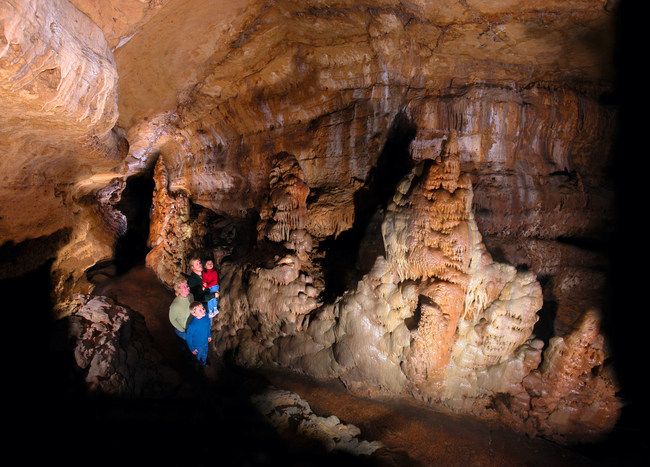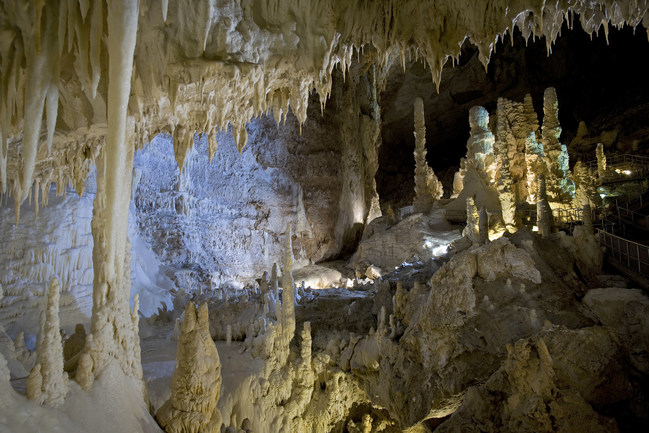FRASASSI/GENGA, Italy, June 4, 2021 /PRNewswire/ — Members of the International Show Caves Association (ISCA), national cave associations from many countries, and countless cave enthusiasts worldwide are joining together to celebrate the International Day of Caves and the Subterranean World on 6th June. For the first time, the celebration will take place during the International Year of Caves and Karst which was launched in January 2021 and will continue through 2022. As part of their combined efforts to increase awareness of caves and karst landscapes, on 6th June show caves around the world will be hosting special events, extending special offers, and providing unique educational opportunities for people at their caves and on social media.
ISCA is also using the day to bring attention to the economic devastation the show cave industry has experienced due to COVID-19’s impact on travel and to spread the word that show caves around the world are open now or in the process of reopening soon as different regions across the world are looking forward to a rebound in tourism. “Show caves worldwide play not only a vital role of protection and preservation of these fragile eco-systems; the show caves themselves are important economic engines in their communities,” said Brad Wuest, president of ISCA.
Worldwide more than 144 million people visit show caves in a normal year; in 2020 94% of show caves closed, for some time period, due to COVID-19. It is estimated that 59% of visitation to these communities was lost, resulting in a similar percentage of temporary job losses. With recovery on the horizon, show cave operators around the world are following health recommendations and government requirements as they welcome visitors back for amazing nature experiences. The goal is for these show cave operators to continue their multifaceted role of stewardship, education, and tourism within their community.
“Everyone is touched by caves and karst. Water, food, cultural history, and scientific research that supports all of our lives and benefits everyone on the planet—not just those living in the 20% of the land that is cavernous and karstic,” said George Veni, President of the International Union of Speleology. Caves and karst landscapes supply 10% of the fresh drinking water to billions of people. They deliver tens of billions of dollars each year to economies through tourism. They serve as habitat for many important species such as bats which eat insects, pollinate, and disperse seeds, reducing pesticide use and supporting the production of foods, medicines, and industrial products. It also provides a bounty of unique scientific knowledge for climate change, mineral resources, agriculture, and even the search for life on other planets.
Caves are diverse in length, size, and shape. Mammoth Cave in Kentucky, USA, is the longest cave on Earth and continues to increase in length as more passage is discovered, currently an astounding length of 663 kilometers (412 miles). Sarawak Chamber in Mulu National Park in Malaysia is the world’s largest cave room by surface area, with some 164,459 square meters (1,770,220 square feet) of expanse. Veryovkina Cave in the Eurasian country of Georgia is the deepest cave in the world at 2,212 meters (7,257 feet).
Exploration and scientific research are still underway in caves around the world by speleologists with caves continually being discovered, surveyed, and studied. Even so, the world is full of caves that have never been seen by a human. Critical scientific insights come from caves: researchers sample formations to track historical weather trends dating back hundreds of thousands of years to learn about climate. Rain and surface water is traced as it percolates through karst landscapes and caves into aquifers to create modeling and better understand how to protect our precious water resources.
“Caves have always attracted people,” said Wuest, “Caves provided shelter to mankind’s earliest ancestors, so early in human history that it is not possible to reliably trace the time that it commenced.” Cave tourism may have begun at the Reed Flute Cave in China with inscriptions from 792 in the time of the Tang Dynasty. The first recorded cave tour in Europe was at Postojna Cave in Slovenia in 1213. Vilenica Cave in Slovenia holds a record for being open to visitors and collecting entrance fees since 1633.
Today, with 144 million visitors, caves are among the most universally visited natural formations around the world.
From Europe to Australia to South and North America, show caves bring families together. Caves can spark a child’s interest in science that could shape their future. Spending time in nature, as evidenced in many studies, can also boost mental and physical well-being, improve concentration, increase energy, reduce stress, and lower blood pressure and heart rates. Activities such as hiking to or in a cave is great for physical fitness too.
The International Show Caves Association (ISCA) was founded in 1990 and is headquartered in Frasassi/Genga, Italy. ISCA is an international organization of persons, associations, corporations, and government agencies who own, manage or operate show caves that are open to the public. ISCA provides a critical forum for show caves to network and collaborate on matters pertaining to their caves. ISCA aims to promote, encourage, and support the cooperation of show cave operators, speleologists and cave enthusiasts through the sharing of information and to promote the preservation and conservation of caves, while increasing public interest in the world of show caves by way of unique marketing and the evolution of methods to enhance the show cave experience.
For more information on the International Show Caves Association and its members, please visit www.i-s-c-a.org.
For more information on the International Union of Speleology, please visit www.uis-speleo.org.
For more information about the International Year of Caves and Karst, please visit www.iyck2021.org.
Media Contacts
Brad Wuest, ISCA President: [email protected], + (1) 210-651-6101
Juan José Tíscar Moya, ISCA Communications Europe: [email protected], +34 660 24 46 50
Winter Prosapio, ISCA Communications USA: [email protected] +(1) 512-888-6570
PHOTO ASSETS AND B-ROLL
Caves and karst photos, logos, and B-Roll are available here.
Video featuring background information about show caves and the International Year of Caves and Karst.
SOURCE International Show Cave Association


